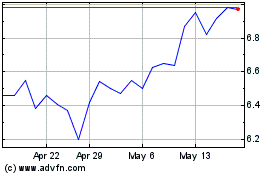Prices for the vital industrial minerals known as rare earths
appear to have moderated in recent weeks following two years of
relentless gains, as the supply outlook brightens and dominant
producer China faces possible legal challenges to export
restrictions.
Rare earths, which is shorthand for a collection of 17 minerals
used to make products from hybrid-car batteries and oil-refining
agents to military equipment, have been surging with prices of some
rising more than tenfold since 2009 amid panic buying. China
controls almost the entire global supply, and its export limits,
mine restructurings and other policies have sparked a frantic
scramble to secure the obscure metals.
Determining prices for rare earths is tricky because the market
for them is illiquid and only small quantities are produced
globally. Some of the biggest buyers and sellers complain that they
have little clarity on pricing.
But Australia's Lynas Corp., which publishes references related
to what it expects to produce at its Mount Weld deposit in the
state of Western Australia, says prices for lanthanum, often used
to make catalysts for refineries, has dropped to $92 per kilogram
as of Sept. 19 from $135.02 in the second quarter. Prices for
cerium, sometimes used in glass, have also dropped to $92 per
kilogram from $138.29 in the second quarter, Lynas says.
On Tuesday, a J.P. Morgan Chase & Co. analyst cited falling
rare-earth prices as a reason to slash his outlook for
Colorado-based Molycorp Inc., a rare-earths producer often
considered an industry bellwether. Its New York Stock
Exchange-listed shares subsequently tumbled nearly 22%.The shares
rose 1.4% to $42.03 in midday trading Wednesday.
Molycorp officials couldn't be reached Wednesday for comment. In
an interview earlier this month, Molycorp Chief Executive Mark
Smith said he has seen signs of "demand destruction" for rare
earths, as companies take steps to reduce their rare-earths use,
such as glass makers recycling cerium. But, expressing confidence
in prices underpinned by Chinese policy, he said, "I go back to the
supply-demand relationship in this industry."
Rare-earth prices remain far above where they were just two
years ago. Lanthanum, for instance, still hovers 18 times above its
2009 price, while prices for cerium are still nearly 25 times
higher, according to Lynas. Indeed, some international prices
haven't fallen at all, in particular those that are known as heavy
rare earths, like terbium, which is used in advanced lasers and
optics.
Still, some industry observers see reason to hope for an end to
what has been constantly climbing prices. "As a general rule,
people think prices are going to drop," says Luther C. Kissam,
chief executive of Albemarle Corp., a Louisiana maker of specialty
chemicals that imports Chinese lanthanum.
Companies are looking for ways to reduce their rare-earth use,
taking some pressure off demand. Manufacturers and industrial
companies such as W.R. Grace & Co. say they have found ways to
reduce the rare-earth content of their products.
Also, Grace said last November that, due to China's rare-earth
export crimps and surging prices, it would charge customers of its
fluid catalytic cracking catalysts a surcharge that it didn't
specify. In subsequent filings, including its 2010 annual report,
Grace cited "the cost of and availability" of rare earths among its
risks. For the first half of 2011, it reported $47.8 million in
accounts receivable and inventories in the period relating to rare
earths.
"We expect that rare earth market conditions could change
quickly, and they remain an uncertainty for the foreseeable
future," Grace said in the half-yearly report last month. But Grace
also said it was developing catalytic products with low or no rare
earth content, and it said many customers were receptive. Company
officials declined to comment.
Still others have moved production to China, freeing them from
China's export restrictions. Hitachi Ltd. is considering moving
some production of high-grade magnets to China, among many other
options, said one executive of the Japanese company.
"Generally speaking, it's wise for a company's management to
keep all options open," the executive said.
Trade lawyers, meanwhile, predict the legality of China's policy
to allocate supplies to foreigners using government quotas will
shortly be undermined by an unrelated, but similar, case being
considered by the World Trade Organization involving a separate
class of minerals. "This is a short-sighted and self-defeating
policy by China," said James Bacchus, global chairman of law firm
Greenberg Traurig LLC and a former chief WTO judge.
China has said it is tightening export limits on rare earths
because processing them takes a toll on the environment. Beijing
says it doesn't want to remain the world's near-monopoly
producer.
A much-watched mineral now is neodymium, an ingredient in
permanent magnets that are used in wind turbines and hybrid cars.
China's largest producer of rare earths this week announced price
supports for it, which could further encourage industry to locate
in the country. Lynas says the price of neodymium has been flat
since midyear on international markets at around $265 per kilogram
but has dipped in China.
It isn't clear whether the pause will last. Given the "wild
card" of Chinese policy, volatile pricing is here to stay,
according to Edward Richardson, vice president of specialized
Indiana magnet maker Thomas & Skinner Inc.
"Without dependable and consistent data, we are left with
stories, anecdotes and perceptions," he said in an email.
-Norihiko Shirouzu in Beijing contributed to this article.
Lynas Rare Earths (ASX:LYC)
Historical Stock Chart
From Dec 2024 to Jan 2025

Lynas Rare Earths (ASX:LYC)
Historical Stock Chart
From Jan 2024 to Jan 2025
